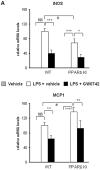Generation and characterization of a humanized PPARδ mouse model
- PMID: 21426320
- PMCID: PMC3171871
- DOI: 10.1111/j.1476-5381.2011.01359.x
Generation and characterization of a humanized PPARδ mouse model
Abstract
Background and purpose: Humanized mice for the nuclear receptor peroxisome proliferator-activated receptor δ (PPARδ), termed PPARδ knock-in (PPARδ KI) mice, were generated for the investigation of functional differences between mouse and human PPARδ and as tools for early drug efficacy assessment.
Experimental approach: Human PPARδ function in lipid metabolism was assessed at baseline, after fasting or when challenged with the GW0742 compound in mice fed a chow diet or high-fat diet (HFD).
Key results: Analysis of PPARδ mRNA levels revealed a hypomorph expression of human PPARδ in liver, macrophages, small intestine and heart, but not in soleus and quadriceps muscles, white adipose tissue and skin. PPARδ KI mice displayed a small decrease of high-density lipoprotein-cholesterol whereas other lipid parameters were unaltered. Plasma metabolic parameters were similar in wild-type and PPARδ KI mice when fed chow or HFD, and following physiological (fasting) and pharmacological (GW0742 compound) activation of PPARδ. Gene expression profiling in liver, soleus muscle and macrophages showed similar gene patterns regulated by mouse and human PPARδ. The anti-inflammatory potential of human PPARδ was also similar to mouse PPARδ in liver and isolated macrophages.
Conclusions and implications: These data indicate that human PPARδ can compensate for mouse PPARδ in the regulation of lipid metabolism and inflammation. Overall, this novel PPARδ KI mouse model shows full responsiveness to pharmacological challenge and represents a useful tool for the preclinical assessment of PPARδ activators with species-specific activity.
© 2011 The Authors. British Journal of Pharmacology © 2011 The British Pharmacological Society.
Figures











Similar articles
-
High-fat feeding in cardiomyocyte-restricted PPARdelta knockout mice leads to cardiac overexpression of lipid metabolic genes but fails to rescue cardiac phenotypes.J Mol Cell Cardiol. 2009 Oct;47(4):536-43. doi: 10.1016/j.yjmcc.2009.07.001. Epub 2009 Jul 9. J Mol Cell Cardiol. 2009. PMID: 19595695 Free PMC article.
-
Both the peroxisome proliferator-activated receptor delta agonist, GW0742, and ezetimibe promote reverse cholesterol transport in mice by reducing intestinal reabsorption of HDL-derived cholesterol.Clin Transl Sci. 2009 Apr;2(2):127-33. doi: 10.1111/j.1752-8062.2009.00098.x. Clin Transl Sci. 2009. PMID: 20169010 Free PMC article.
-
Peroxisome proliferator-activated receptor δ agonist GW1516 attenuates diet-induced aortic inflammation, insulin resistance, and atherosclerosis in low-density lipoprotein receptor knockout mice.Arterioscler Thromb Vasc Biol. 2014 Jan;34(1):52-60. doi: 10.1161/ATVBAHA.113.301830. Epub 2013 Oct 24. Arterioscler Thromb Vasc Biol. 2014. PMID: 24158519
-
Peroxisome proliferator-activated receptor δ: a multifaceted metabolic player.Curr Opin Lipidol. 2013 Apr;24(2):171-7. doi: 10.1097/MOL.0b013e32835cc949. Curr Opin Lipidol. 2013. PMID: 23481229 Review.
-
PPARdelta in humans: genetic and pharmacological evidence for a significant metabolic function.Curr Opin Lipidol. 2009 Aug;20(4):333-6. doi: 10.1097/MOL.0b013e32832dd4b1. Curr Opin Lipidol. 2009. PMID: 19512923 Review.
Cited by
-
Dissecting the role of peroxisome proliferator-activated receptor-β/δ (PPARβ/δ) in colon, breast, and lung carcinogenesis.Cancer Metastasis Rev. 2011 Dec;30(3-4):619-40. doi: 10.1007/s10555-011-9320-1. Cancer Metastasis Rev. 2011. PMID: 22037942 Free PMC article. Review.
-
Genomically humanized mice: technologies and promises.Nat Rev Genet. 2011 Dec 16;13(1):14-20. doi: 10.1038/nrg3116. Nat Rev Genet. 2011. PMID: 22179716 Free PMC article. Review.
-
Nuclear control of the inflammatory response in mammals by peroxisome proliferator-activated receptors.PPAR Res. 2013;2013:613864. doi: 10.1155/2013/613864. Epub 2013 Mar 7. PPAR Res. 2013. PMID: 23577023 Free PMC article.
-
Conditional Expression of Human PPARδ and a Dominant Negative Variant of hPPARδ In Vivo.PPAR Res. 2012;2012:216817. doi: 10.1155/2012/216817. Epub 2012 Mar 21. PPAR Res. 2012. PMID: 22550474 Free PMC article.
-
Systematic target function annotation of human transcription factors.BMC Biol. 2018 Jan 10;16(1):4. doi: 10.1186/s12915-017-0469-0. BMC Biol. 2018. PMID: 29325558 Free PMC article.
References
-
- Briand F, Naik SU, Fuki I, Millar JS, Macphee C, Walker M, et al. Both the peroxisome proliferator-activated receptor (PPAR) delta agonist, GW0742, and ezetimibe promote reverse cholesterol transport in mice by reducing intestinal re-absorption of HDL-derived cholesterol. Clin Transl Sci. 2009;2:127–133. - PMC - PubMed
Publication types
MeSH terms
Substances
LinkOut - more resources
Full Text Sources
Other Literature Sources
Molecular Biology Databases

